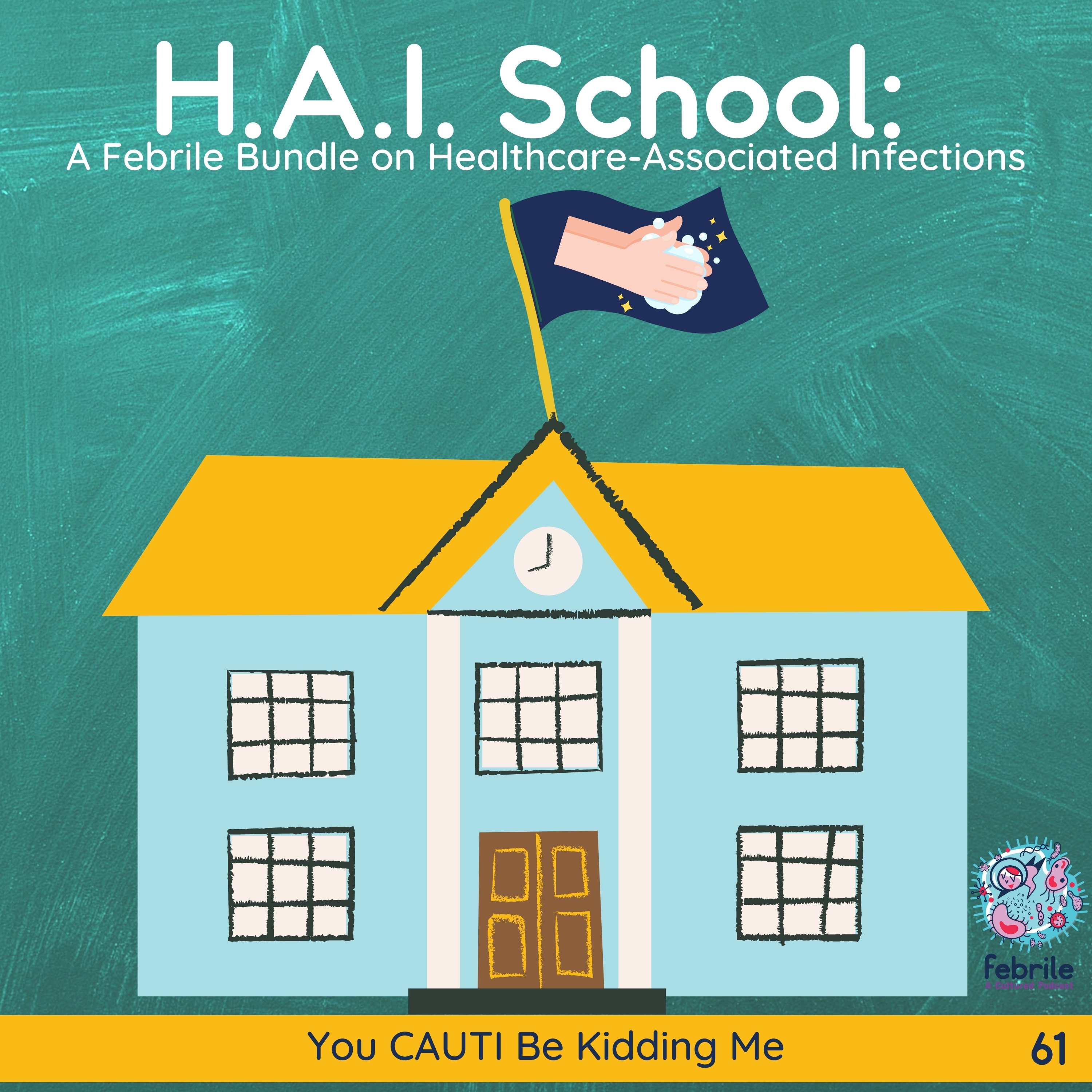Table of Contents
Credits
Hosts: Jeremy Steinbruck, Sara Dong
Guest: Nicholas Gilpin
Writing: Jeremy Steinbruck, Sara Dong
Producing/Editing/Cover Art/Infographics: Sara Dong
Our Guests
Guest Co-Host
Jeremy Steinbruck, MD

Dr. Jeremy Steinbruck completed his undergraduate training at University of Massachusetts Boston. He then earned his medical degree in Dominica at Ross University School of Medicine, where he did clinicals at Far Rockaway NY and Michigan. He completed residency at Carilion Clinic in Roanoke, VA, and he is now back in Michigan for his first year of ID fellowship at Beaumont Royal Oak
Guest Discussant
Nicholas Gilpin, DO

Dr. Nick Gilpin is an infectious disease physician with Beaumont Health, an 8-hospital healthcare system located in southeast Michigan. He currently serves as the Medical Director of Infection Prevention and Epidemiology for Beaumont Royal Oak, a 1,131-bed major academic and referral center with Level I adult trauma and Level II pediatric trauma designations. He is also the Medical Director of Infection Prevention for the Beaumont Health System.
Dr. Gilpin earned his medical degree from Michigan State University College of Osteopathic Medicine in 2006. He completed an internship and residency in internal medicine at Ascension St. John Providence Hospital in Southfield, MI from 2006 to 2009, and he completed his infectious diseases fellowship training at Beaumont Royal Oak in 2011. Dr. Gilpin is currently an assistant professor with the Oakland University William Beaumont School of Medicine and the Michigan State University College of Osteopathic Medicine.
Consult Notes
Consult Q
Patient with Foley in place has a fever, concern for UTI – assistance with treatment?
Key Points
The HAI School Series! HAI = Healthcare Acquired Infections
This episode is #2 of 4 in another Febrile series, this time entitled “HAI School”! This bundle of episodes will discuss some healthcare associated infections (CLABSI, CAUTI, SSI, and VAP). Check out all four episodes (#60-63) to hear them all! The first three are from a team from Beaumont Health, and the fourth episodes features a team from the University of Michigan
Let’s start with the basics! What is a CAUTI?
- Among urinary tract infections (UTI) acquired in the hospital, ~75% are associated with urinary catheter
- For surveillance purposes, a catheter associated UTI (CAUTI) occurs when a patient develops a UTI when an indwelling urinary catheter is in place for more than 2 days before the event date
- Let’s start with some clinical definitions
- Asymptomatic bacteriuria = Culture growth of ≥10^5 cfu/mL of uropathogenic bacteria in absence of symptoms compatible with UTI in a patient with indwelling urethral, indwelling suprapubic, or intermittent catheterization
- Symptomatic bacteriuria (UTI) = Culture growth of ≥10^3 cfu/mL of uropathogenic bacteria with symptoms or signs compatible with UTI without other identifiable source in a patient with indwelling urethral, indwelling suprapubic, or intermittent catheterization
- Symptoms include fever, suprapubic or costovertebral angle tenderness, and otherwise unexplained systemic symptoms
- Patients who are no longer catheterized but had catheter within past 48 hrs are also considered to meet these definitions
- Although a bit older now, here’s the 2009 IDSA guidelines: Hooton TM, Bradley SF, Cardenas DD, et al. Diagnosis, prevention, and treatment of catheter-associated urinary tract infection in adults: 2009 International Clinical Practice Guidelines from the Infectious Diseases Society of America. Clin Infect Dis. 2010;50(5):625-663. doi:10.1086/650482
- Those definitions are different from what is used by the CDC NHSN, which were created for surveillance
- NHSN = CDC’s National Healthcare Safety Network (NHSN), which is a HAI tracking system
- Asymptomatic bacteriuria definition is the same
- Catheter-associated urinary tract infection (CAUTI) = presence of fever, suprapubic tenderness, or costovertebral angle pain in setting of urine culture with bacterial counts >=10^5 cfu/mL of no more than two organisms
- Does not include fungal isolates or minor pathogens
- Suprapubic catheters, nephrostomy tubes, ileal conduits – not considered indwelling catheters according to NHSN, so excluded
- Here’s the NHSN document with more details on UTI events, updated Jan 2023
- Nick explained how the NHSN definition lacks specificity as it is a surveillance definition (not a clinical one)
- The NHSN definition does not allow for other attribution of fever, so it likely overestimate the rate of clinically relevant catheter related bacteriuria
- The definition can also change and make it difficult to compare infection rates over time
- Bardossy AC, Jayaprakash R, Alangaden AC, et al. Impact and Limitations of the 2015 National Health and Safety Network Case Definition on Catheter-Associated Urinary Tract Infection Rates. Infect Control Hosp Epidemiol. 2017;38(2):239-241. doi:10.1017/ice.2016.278
- Neelakanta A, Sharma S, Kesani VP, et al. Impact of changes in the NHSN catheter-associated urinary tract infection (CAUTI) surveillance criteria on the frequency and epidemiology of CAUTI in intensive care units (ICUs). Infect Control Hosp Epidemiol. 2015;36(3):346-349. doi:10.1017/ice.2014.67
- You can also read more about CAUTI 101 in this slide deck from the CDC, Health Research & Educational Trust (HRET), and STRIVE (States Targeting Reduction in Infections via Engagement)
Epidemiology and Risk Factors of CAUTI Infections
- Bacteriuria in patients with indwelling catheters occurs at rate of approximately 3-7% per day of catheterization
- To check on the latest data, you can access some info at the CDC website, such as:
- Current National and State HAI Progress Report, where data tables and summaries are available
- National and State Factsheets are available at the Antibiotic Resistance & Patient Safety Portal
- The most important risk factor for CAUTI is the duration of catheterization
- Other risk factors:
- Female sex
- Older age
- Diabetes mellitus
- Bacterial colonization of the drainage bag
- Errors in catheter care (such as errors in sterile technique, not maintaining a closed drainage system, etc)
Diagnosing CAUTI
- As discussed in the episode, the diagnosis is made by identifying bacteriuria in a catheterized patients who has signs and symptoms consistent with UTI or systemic infection
- A UTI diagnosed in a patient who has had catheter removed in the past 48 hrs is also considered a CAUTI
- Ideally urine culture samples should be obtained by removing the catheter and obtaining a midstream specimen
- If ongoing catheterization is needed, the catheter should be replaced prior to collecting the sample to avoid culturing bacteria present in the biofilm of the catheter (rather than the bladder)
What is the pathophysiology of CAUTI?
Organisms can enter the bladder:
- At the time of catheter insertion
- Through the catheter lumen (from a colonized drainage bag)
- Along external surface of catheter (migrate along catheter-mucosal surface)
Microbiology of CAUTIs
The pathogens to consider for CAUTI are similar to what you might consider with complicated UTI:
- E.coli and Enterobacteriaceae
- Pseudomonas aeruginosa
- Enterococci
- Staphylococci
CAUTI Management
- We mentioned the IDSA guidelines earlier in the Consult Notes: IDSA Clinical Practice Guidelines for the Diagnosis, Prevention, and Treatment of Catheter-Associated Urinary Tract Infection, 2009
- Don’t forget to check if you have local guidance as well
- In general though, management consists of catheter removal/management and antibiotic therapy
- We won’t focus on the specific antimicrobial selection here, but some key steps include:
- Consider whether infection as extended beyond the bladder and treat accordingly (complicated UTI vs acute simple cystitis)
- Consider risk factors for resistant infection (prior micro and/or recent antimicrobial use, healthcare exposures)
- The optimal management step is minimizing the use of indwelling catheters when possible!
- If patient no longer requires catheterization, remove the catheter!
- Intermittent catheterization is associated with a lower rate of bacteriuria and UTI than long term indwelling cathterization
Preventing CAUTI
- In addition to the IDSA guidance noted throughout the Consult Notes, you can find recommendations here from a panel sponsored by SHEA: Lo E, Nicolle LE, Coffin SE, et al. Strategies to prevent catheter-associated urinary tract infections in acute care hospitals: 2014 update. Infect Control Hosp Epidemiol. 2014;35(5):464-479. doi:10.1086/675718
- How can we reduce catheter use and prevent CAUTI?
- Avoid placement!
- Place indwelling urinary catheter only for appropriate indications
- Encourage use of alternatives to indwelling urinary catheters
- Prevent improper placement
- Ensure proper aseptic insertion technique
- Ensure awareness and proper maintenance care of catheters in place
- Optimize prompt removal of unnecessary catheters
- Conduct daily catheter rounds
- Urinary catheter reminders and stop orders
- Assess catheter needs at key points, such as transfer
- Other targeted educational options might include:
- Feedback infection and catheter usage to frontline staff
- Perform focused reviews of infections and root-cause analysis when needed
- Observation of competency of catheter insertion
- Urine culture stewardship!
- Culture only if symptoms of UTI are present
- Avoid placement!
- A few resources:
- There are some available needs assessment online for CAUTI. Check out this webpage (was called CatheterOut, becoming BladderSafe) and their resources page
- The Targeted Assessment for Prevention (TAP) Strategy is a framework for QI developed by the CDC to prevent HAI. They have some videos on the page along with resources on how to use
- Meddings J, Saint S. Disrupting the life cycle of the urinary catheter. Clin Infect Dis. 2011;52(11):1291-1293. doi:10.1093/cid/cir195
- Meddings J, Saint S, Fowler KE, et al. The Ann Arbor Criteria for Appropriate Urinary Catheter Use in Hospitalized Medical Patients: Results Obtained by Using the RAND/UCLA Appropriateness Method. Ann Intern Med. 2015;162(9 Suppl):S1-S34. doi:10.7326/M14-1304
- Saint S, Greene MT, Krein SL, et al. A Program to Prevent Catheter-Associated Urinary Tract Infection in Acute Care. N Engl J Med. 2016;374(22):2111-2119. doi:10.1056/NEJMoa1504906
- There is no clear benefit to using prophylactic antibiotics to reduce the risk of CAUTI
Infographics
Goal
Listeners will be able to understand the definition, evaluation, and management of catheter-associated urinary tract infections
Learning Objectives
After listening to this episode, listeners will be able to:
- Recognize that catheter associated urinary tract infections (CAUTIs) can be defined by both clinical and surveillance perspectives
- Recognize the routes and risk factors of developing CAUTI
- Describe strategies for CAUTI prevention
Disclosures
Our guests (Jeremy Steinbruck and Nicholas Gilpin) as well as Febrile podcast and hosts report no relevant financial disclosures
Citation
Gilpin, N., Steinbruck, J., Dong, S. “#61: HAI School: A Febrile Bundle on Healthcare-Associated Infections #2 – You CAUTI Be Kidding Me”. Febrile: A Cultured Podcast. https://player.captivate.fm/episode/4987ad72-d86d-4896-a63a-cbe2ea69bc2b


